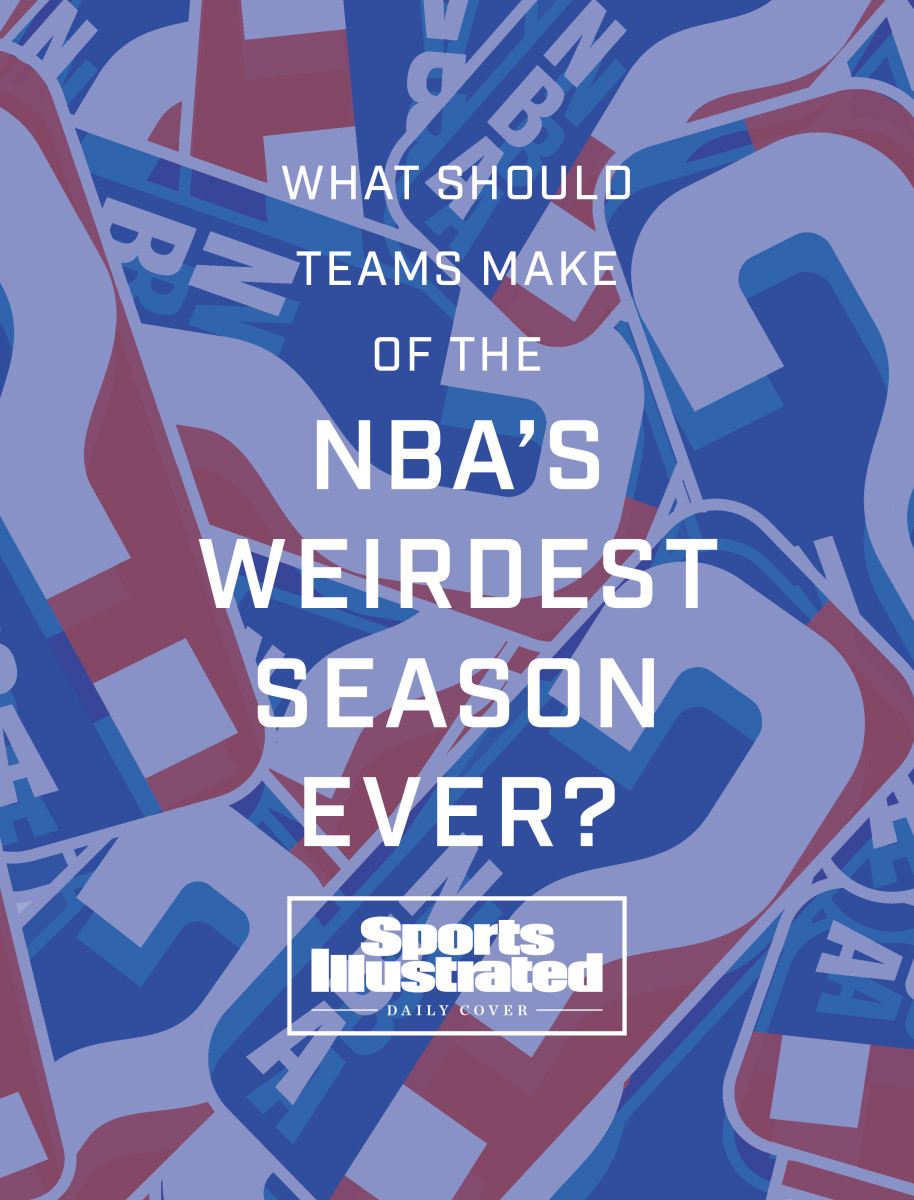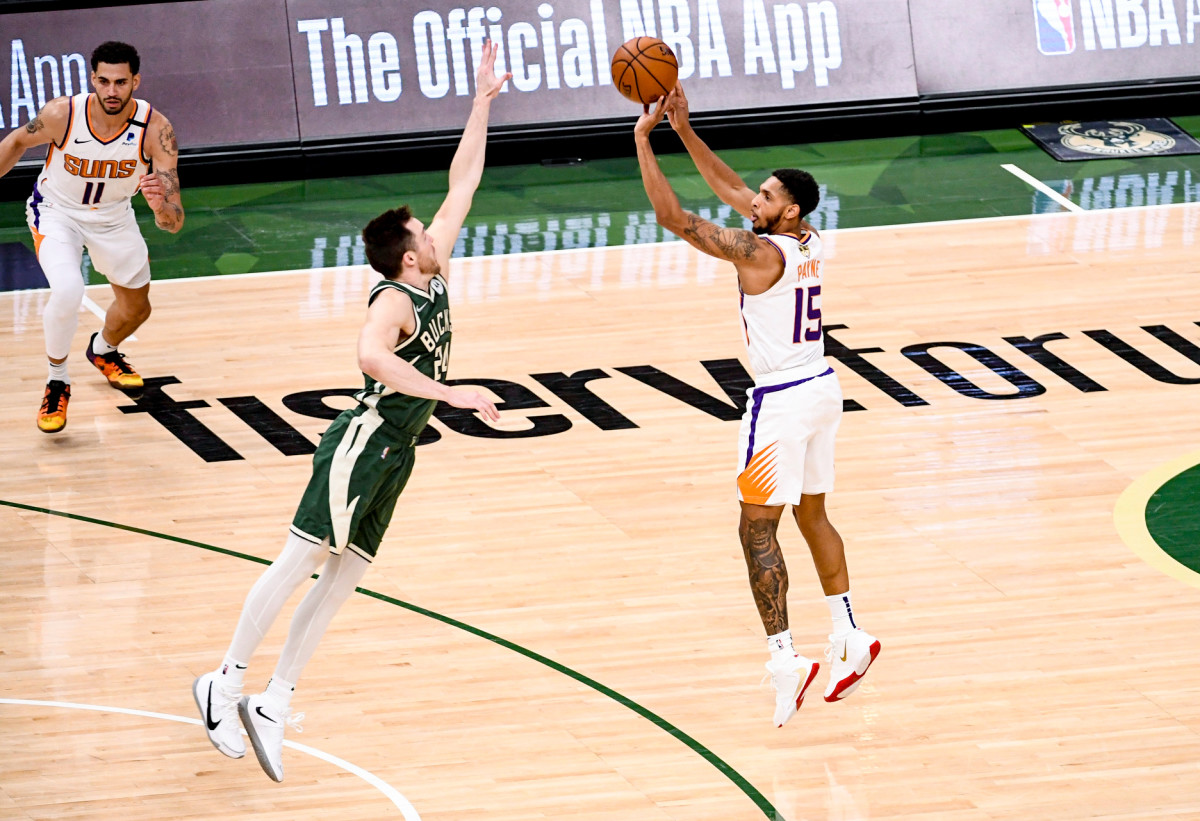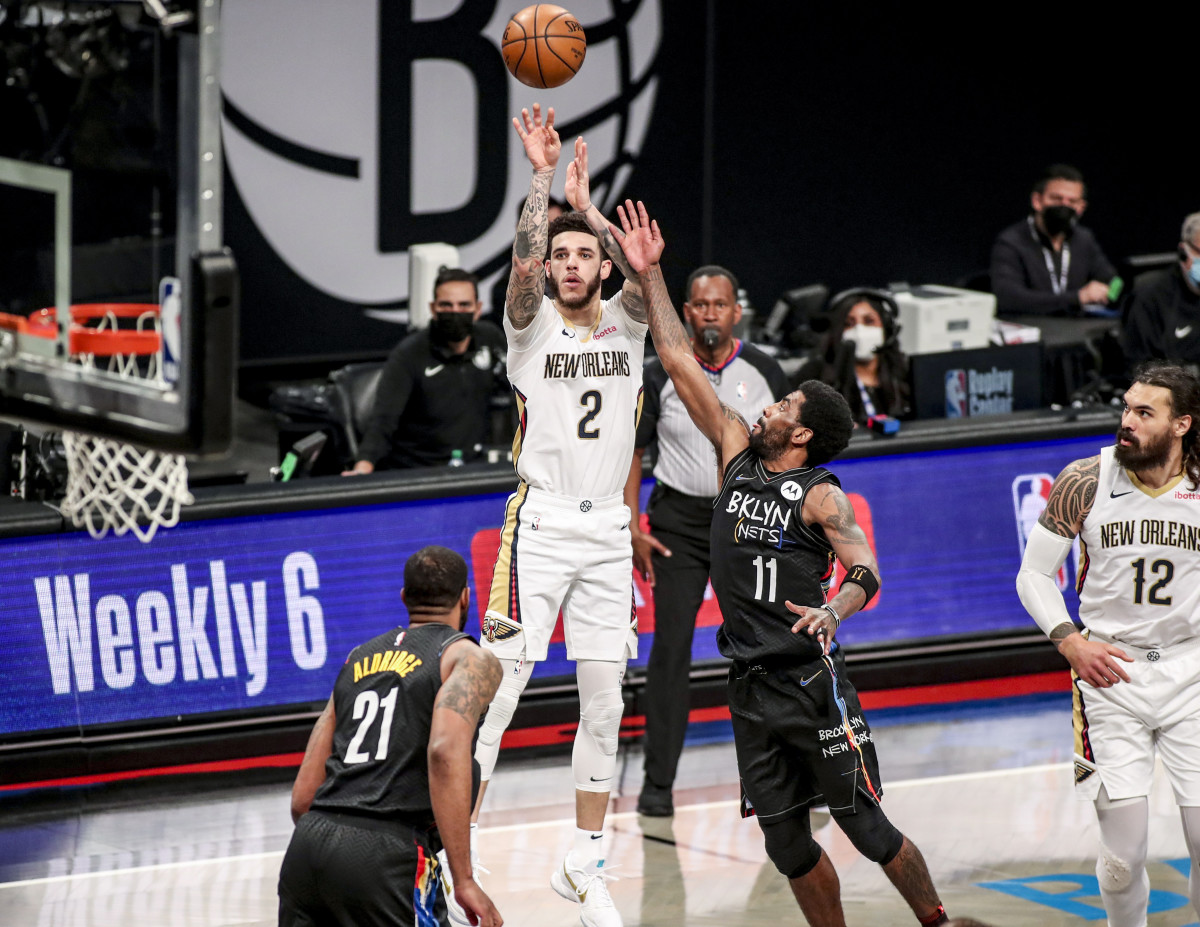Does Anything That Happened in the NBA This Season Mean Anything?
On the day he should have been preparing for another playoff run, Masai Ujiri was instead sitting in an empty gym, engaging in the most 2021 of activities: a Zoom call. This one was a virtual press conference, arranged so Ujiri, president of basketball operations for the Raptors, could give an autopsy on a season gone horribly wrong.
The Raptors had finished 27–45, 12th in the Eastern Conference, missing the postseason for the first time in eight years—despite a roster with six players from their 2019 championship run. Just last summer, they’d made a spirited run to Game 7 of the conference semifinals. Their nosedive was one of the more shocking developments of the NBA’s pandemic-warped season.
And now Ujiri was trying to make sense of it all. To draw some meaning from the wreckage. What, he was asked, did you learn about your team?
“It’s a tough year to evaluate,” Ujiri replied, mostly because “none of us have gone through this before.”

“This,” meaning a compressed and truncated 72-game season. A season with little time for practice or recovery. A season of early-morning COVID-19 tests and player quarantines and postponed games. A season marred by a slew of injuries to All-Stars. A season played mostly in empty arenas, with no fans and no home-court advantage. And, in the Raptors’ case, no home games at all. Restrictions in Ontario forced them to relocate to Tampa—meaning they were the only team to play, in effect, 72 road games.
“Our case,” Ujiri said, “was even worse than the 29 other teams.”
It wasn’t a plea for sympathy, just necessary context. How do you evaluate the single strangest, most stressful season in NBA history? Who the hell knows? And it’s not just the Raptors who are wrestling with the question as they make plans for the draft and free agency. It’s all 30 teams. And it’s actually a slew of questions, such as …
How reliable are shooting percentages, given the empty buildings? If your rookie thrived, can he do the same before a hostile crowd? If your rookie struggled, was it just the lack of practice time and Summer League? Which breakout performances were legitimate—and replicable? How much faith do you place in individual player stats? In the final standings?
This is not to say the season wasn’t legitimate. This isn’t about asterisks. But how much did executives and scouts actually learn about their teams, their rivals, their next free-agent targets? That part is incredibly tricky.
“I don’t think you can look at it just like any other year,” says former Pelicans coach Stan Van Gundy, who was fired in June. “Because you don’t know how much it affected an individual player or an individual team.”
Says a pro personnel director: “There’s so many things that were different this year that you don’t know how they’re going to be next year if things return to normal.”
Or, as one assistant general manager put it: “It’s a funky season, for sure. I wouldn’t say it’s extreme to call it warped.”

Start with home-court advantage. In effect, there wasn’t any. Home teams won just 54.3% of their games this season, the worst mark in league history, and well below the all-time average of 62%. Eleven teams finished with losing records at home, tying for the most ever. So teams have to be cautious about interpreting individual player stats, given the relatively placid environment.
Playing in empty buildings cost the home team about 1.74 points per game, according to a study by Scott Ganz, a visiting assistant professor at the Georgetown University McDonough School of Business. Using data from this season—which began with zero fans in attendance, but ended with fans in most arenas—Ganz concluded that home teams won by an average of 2.13 points with fans present, but just 0.39 points without them.
Which underscores what athletes, fans and pundits have long believed: “Having thousands of people cheering for you is gonna give you some energy and make you play better,” Ganz says.
Researchers like Ganz call this “emotional contagion”—and his study suggests it plays a much greater role in the NBA’s home-court advantage than travel, officiating or other factors. Even the presence of a few thousand fans made a quantifiable impact on the home-court edge late in the season, when the league began allowing small numbers to attend, Ganz found.
But home teams largely didn’t get that emotional boost this season. And road teams had nothing to get rattled about. All of which had a palpable impact on performance, effectively juicing offensive efficiency.
Home teams posted an effective field goal percentage (which combines two-pointers and three-pointers) of .541 this season, compared with .535 for road teams. That 0.006 margin is the slimmest since the three-point shot was introduced in 1979–80 and half what it was in 2019-20, according to Justin Kubatko, the president of Statitudes LLC and the creator of Basketball-Reference.com.
The NBA this season also set an all-time high in true shooting percentage (which combines two-pointers, three-pointers and free throws): 57.2%. That stat has been steadily climbing for years, Kubatko notes. So the boost might not be entirely pandemic-related, but it’s noteworthy.
Meanwhile, the league’s turnover rate was a record-low 12.4 per 100 possessions. Combine that with the sizzling shooting, Kubatko says, “and you get crazy overall offensive efficiency”—including a leaguewide offensive rating of 112.3—another record.
The NBA this season also set or tied records for free throw percentage (.778), 3-point percentage (.367) and effective field goal percentage (.538).
Did offenses get some sort of pandemic-year boost? Did players shoot better because they were more relaxed without screaming fans? Or did players get more time to refine their shooting with all the downtime last year? Sure, the teams that made deep playoff runs had terribly short offseasons, but those that missed the postseason had historically long layoffs.
“During COVID, the easiest thing to do was get shots up,” says a Western Conference team executive, offering one popular theory. “The other one is that the limit on practice time hurts defense more than offense.”

Among other anomalies, per Kubatko: Nearly one in five games was decided by 20 or more points, the second-highest rate ever. The average game was decided by 12.18 points, also the second highest ever. What does that mean for player evaluation? Who knows? But every sign of a warped season is a reason to pause.
All of these stats present talent evaluators with a probably unsolvable puzzle: Which of these seeming anomalies are sustainable and which are, well, just anomalies?
Knicks veteran Julius Randle, for instance, made a massive leap in three-point percentage, from .277 to .411, and made the All-NBA team for the first time. Can the Knicks expect the same next season? What does that mean for contract extension talks this summer?
Bucks reserve Bobby Portis shot 47% from the arc, smashing his prior career average of 36%. Is that sustainable? What about Suns reserve Cameron Payne, who has made 45% of his threes since joining Phoenix last summer, after shooting 33% in his first four NBA seasons? Payne will soon be a free agent, and Portis could be, too. Do you pay them like elite shooters?
“I would say any time a player has a breakout performance, you should have a healthy level of skepticism about it being sustainable,” says the Western Conference team executive.
Drilling down further, an analysis of catch-and-shoot accuracy showed virtually no difference between home and road performance this season, according to Kostas Pelechrinis, a statistical analyst who has consulted for NBA teams. In the prior two seasons, players shot 1.4% to 1.7% better at home than on the road.
“These data provide some evidence that the … gap in the catch-and-shoot performance of players at home and on the road was practically eliminated this season,” Pelechrinis says in an email. “From what data we have right now, it will be hard to say if this will persist next season.”
Among the players who seemed to benefit most this season, per Pelechrinis: Paul George of the Clippers, Myles Turner of the Pacers and free agents to be Lonzo Ball of the Pelicans and Kendrick Nunn of the Heat.
George, for instance, posted an eFG percentage of 61 on the road and 66.5 at home on catch-and-shoot jumpers—a gap of just 5.5 percentage points; whereas last season he shot 69.4% at home and 48% on the road, a startling 21-point gap. (These stats, provided by Pelechrinis, exclude games played in the NBA bubble last summer, since those games were also in empty arenas.)
Ball’s eFG percentage on catch-and-shoot jumpers was 64.7 at home and 56.7 on the road this season, a gap of 8 points; whereas last season he shot 68.1% at home and 47.9% on the road, for a 20-point gap.
Nunn’s home/road differential on catch-and-shoots dropped to 0.4 percentage points this season, from 13.2 last season. Turner’s dropped to 2.2 percentage points this season, from 19.3 last season.
So yes, fans do have an impact on games and players and outcomes. And yes, that means this past season was like no other before it—and presumably (hopefully), like none we’ll see again.
“You can throw out so many things,” says the pro personnel director. “We don’t know what half these kids will do when they’re on the road, in an environment with screaming fans.”

To Bulls veteran Thaddeus Young, the season did provide some value: as a gauge of how players and teams cope with duress.
“We were faced with a lot of adversity and a lot of challenges to get through this season,” Young says. “We didn’t have fans. We didn’t have appropriate times to practice sometimes. Our families weren’t able to really travel with us. We had to show up to the gym at specific times, especially if somebody caught COVID.”
Maybe the toughest group to evaluate? Rookies. They didn’t get the benefit of a Summer League, or a full training camp. And their first season offered very little practice time. How do the Warriors evaluate No. 2 pick James Wiseman, who arrived as a raw 19-year-old, occasionally thrived, often struggled and ultimately played just 39 games because of injuries? And, since Wiseman is the Warriors’ best trade chip (along with the Nos. 7 and 14 picks in this month’s draft): How does the rest of the league assess him?
“It is much harder to evaluate the younger guys,” says the assistant general manager. “They didn’t have a full summer. Their (college) season ended in March. And then they didn’t play any organized games or organized practices until December. That’s probably the longest they’ve ever gone without playing basketball in their lives. And then to get thrown into the toughest competition they’ve ever faced.”
He adds, “I really take all the rookie seasons with a grain of salt—they’re not as good as you thought, and they’re not as bad as you thought.”
There was so much else clouding the picture this season. The Wizards lost a full two weeks of games and practices in January, because of COVID-19 quarantines. The Heat were derailed when Jimmy Butler got the virus, and the Celtics got sideways when Jayson Tatum caught it—to say nothing of how long it took players to fully regain their strength even after they returned. The Raptors lost star Pascal Siakam—and nearly their entire coaching staff—to COVID-19-related issues in late February, and promptly lost nine of their next 10 games.
The Heat, Celtics, Raptors, Pacers and Wizards all underachieved this season. Can team officials assume a bounce back given “normal” conditions in the fall? The Knicks and Hawks were boosted in part by their rivals’ pandemic-induced travails. Can they count on repeating their success without all the weirdness?
“I think the difficulty is I’m not sure anyone’s ever going to be able to figure out what’s attributable to what,” says Raptors GM Bobby Webster. “Was it the [COVID-19] protocols? Was it a COVID outbreak? Was it the empty [arenas]? It all mixed tougher and affected teams in different ways.”
Then there was the compressed schedule; the raft of injuries, especially to star players; the COVID-19 tests, sometimes two or three per day, often early in the morning; the restrictions on socializing and daily routines. Even commissioner Adam Silver sounded exhausted from it all.
“It’s just been an enormous physical and emotional burden on everyone,” Silver said in his pre-Finals address. “I think we see that every day.”
This postseason reflected the strain and the strangeness.
Neither No. 1 seed made the conference finals—just the second time that’s happened since 1983–84, per the Elias Sports Bureau. Two teams that made the conference finals (the Hawks and Clippers) did so after finishing outside the top three in their conference—also just the second time that’s happened since 1984.
The Suns made the Finals after a 10-year playoff drought—the first time that’s ever happened. Their rise was aided in part by injuries to rival stars: LeBron James and Anthony Davis of the Lakers, Jamal Murray of the Nuggets, Kawhi Leonard of the Clippers. The Bucks also caught a break on their way to the Finals—injuries to Nets stars James Harden and Kyrie Irving, and Hawks star Trae Young. All told, a record 10 All-Stars missed at least one playoff game this year.
It doesn’t mean the 2021 Finals gets an asterisk. It doesn’t mean the champion is diminished, or the results are invalid. But this bizarro-world season does require a massive caveat: Interpret it all at your own risk. That’s what GMs and scouts across the league will be doing this summer, as they ponder who to draft, who to trade, who to sign (and for how much)—wading through the ambiguities and anomalies, grasping for some hint of reliable data.
“You’re making your best guess,” Van Gundy says. “You’re getting the best information you can—and making the best guess.”
More NBA Coverage:
• Suns' Development Program Mines Another Gem in Cam Johnson
• Bobby Portis is the Bucks' Unsung Hero
• Giannis Is Seizing His NBA Finals Moment
